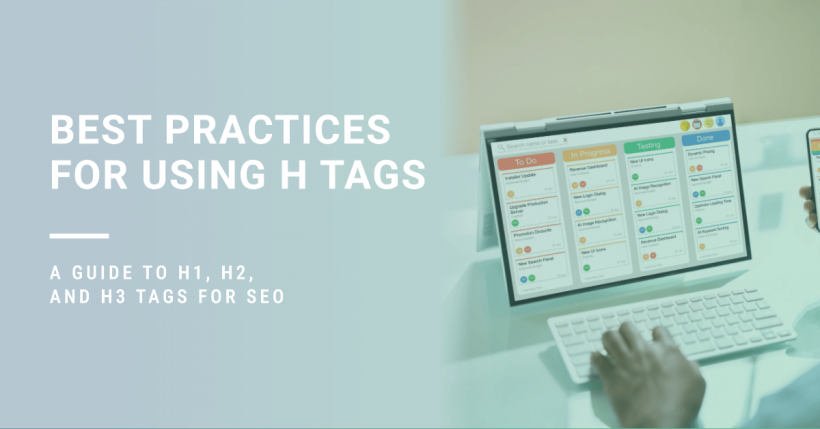
Proper header tags are one of the most important on-page SEO best practices. Headings like h1, h2, and h3 help search engines understand the structure and content of your web pages. They also make your content more readable for users.
This guide will teach you about utilizing heading tags for better SEO and user experience.
Key Takeaways
- Use one H1 tag per page that targets primary keywords
- Include 2-4 h2 subheadings for key sections
- Use h3 tags sparingly for tertiary content
- Maintain a logical heading structure
- Include keywords naturally
- Avoid multiple h1s, improper hierarchy, and stuffing
- Track performance in search and analytics
What Are Headings and Why Do They Matter for SEO?
Header tags are HTML elements used to define headings and subheadings on a web page.
The main headings are:
- h1 – The main page heading
- h2 – Subheadings under the h1
- h3 – Sub-subheadings under h2
Additional h4, h5, and h6 tags can be used for lower-level headings.
There are a few key reasons why header tags are essential for search engine optimization:
- Help search engines understand the topic and structure of your content.
- Provide opportunities to include keywords in your headings.
- Make pages more readable and navigable for users.
According to Google, headings can help search bots grasp a page’s context and content. Well-structured heading tags provide clear cues about each section’s focus.
In short, headings help you optimize pages for search engines and improve the experience for visitors. Using them correctly should be part of every content marketing and SEO strategy.
Best Practices for Utilizing Header Tags
Now, let’s examine some best practices for leveraging h1, h2, and h3 tags.
Use Only One H1 Header Per Page.
Each page should have just one primary tag. This helps establish the primary topic of that page.
For instance, if you have a post about ” keyword research“, the h1 should likely contain the words “keyword research”.
Don’t use many h1 tags or dilute the importance of your main heading.
Include Primary Keywords in h1 Tags.
The h1 tag presents a prime opportunity to establish the page’s focus using your most crucial keyword and topic. Make sure to work your primary keywords into the h1 heading naturally.
🚀 Pro Tip: Don’t cram too many keywords into h1s as it looks spammy. Keep the first heading clean, concise and focused on the core topic.
Utilize h2 Tags for Main Subsections
Use h2 subheadings to divide your content into logical sections under the main page focus defined in the h1.
- Each section or subsection should have its h2 subheading.
- Most pages should have 2-4 h2 tags. More than 4 can make the page crowded.
- Include secondary keywords in h2 headings, but don’t overload them. Keep the headings concise.
Use h3 Headings for Tertiary Sections
Further, break down h2 sections with h3 tags for third-level headings.
- Use h3s sparingly. They are best for in-depth articles and lengthy guides.
- Include related keywords in h3 headings.
Structure Content with a Logical Heading Hierarchy
The heading tags on your page should follow a logical hierarchy based on the content. Here are some tips for structuring your content:
- Review if your h1 and h2 headings cover the main topics and sections.
- Make sure the flow from h1 to h2 to h3 makes sense.
- Use heading tags to create an outline of your content.
- Check if the hierarchy helps a user quickly grasp your content.
- Use transition words to connect headings and improve flow.
Optimize Header Tags for Accessibility
Make sure your headings follow accessibility best practices as well. Here are some tips:
- Don’t skip heading levels, like going from h1 to h3.
- Use brief, descriptive headings.
- Don’t use headings for formatting text – use CSS instead.
This improves access for disabled users relying on screen readers.
Common Heading Issues to Avoid
Now that we’ve covered best SEO practices, let’s discuss some problematic header tag scenarios you should avoid:
Don’t Use Multiple h1 Tags
One of the biggest mistakes is using more than one main header. This confuses search engines about the page’s focus. Stick to a single H1 tag per page.
Avoid Header Tag Stuffing
Don’t overload headings with too many keywords in an attempt to enhance them. Search engines like Google will consider this spammy.
Maintain Logical Header Order
Don’t skip header levels or use them out of order, like h1 to h3. The hierarchy should make sense.
Don’t Use Headers Just for Formatting
Search engines may discount content that uses headers to make text bigger or bolder. Instead, use proper HTML code and CSS for formatting.
By avoiding these mistakes, your use of header tags will be more effective!
Tracking Performance
To ensure your headings are correctly used, you must track their effectiveness over time. Here are some tips:
- Use SEO tools: Audit pages with tools like SEMrush, Ahrefs, or Moz to analyze heading tag usage. Identify which pages need better header optimization.
- Check search results: See if your h1 and h2 align with page title tags and meta descriptions in search engine results. Update tags if needed.
- Monitor keyword rankings: Track ranking progress for keywords targeted in h1, h2, and h3 tags. Tweak tags if some keywords are underperforming.
- Review analytics: Use Google Analytics to check page bounce rates. High bounce rates may indicate poor header structure.
Conclusion
These guidelines will help your pages rank higher and create a better visitor experience. Header optimization should be crucial to your ongoing content and SEO strategy.